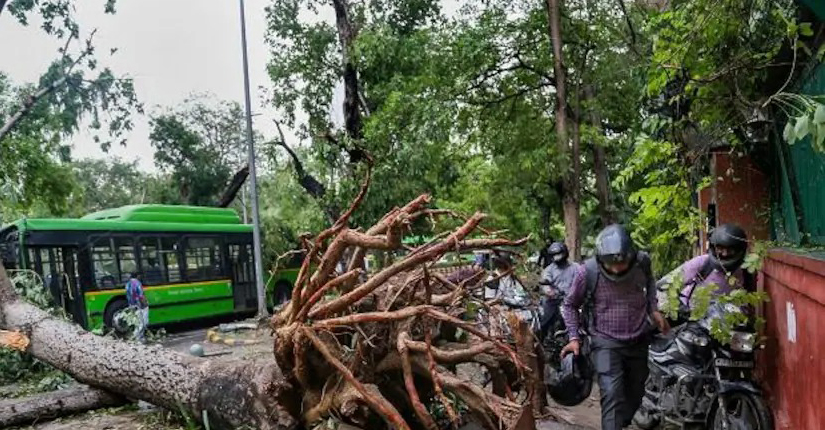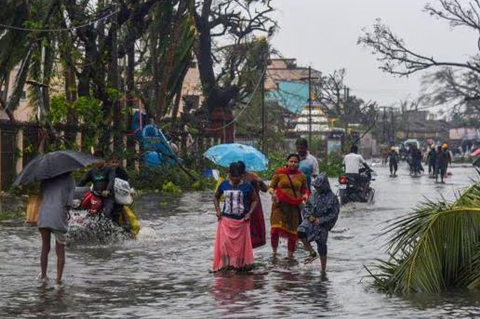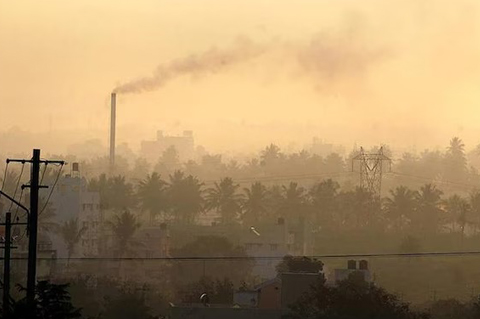The recent storm that moved through Delhi and its neighboring regions during late May 2025 brought a new level of cyclonic fury to the national capital.
Extreme weather systems impact Delhi frequently without warning, yet the recent cyclonic event, which hit multiple Delhi areas in late May 2025, stands as a forceful demonstration of natural power. This article reveals the scientific explanation behind and the effects of the most recent Delhi cyclone while describing the resulting chaos that affected residents and emergency officials.
The Cyclonic Circulation Developed Instantly Without Warning
Nightfall on May 21, 2025, brought a fast-moving atmospheric change to Delhi and the surrounding NCR area. The weather transitioned from extreme heat during the morning when temperatures reached an equivalent of 50.2°C, before a powerful dust storm with hail and heavy rain and 79 kmph winds struck the area. The India Meteorological Department (IMD) located the source as a cyclonic circulation that existed over Haryana within an east-west trough that extended from Punjab to Bangladesh and was being sustained by Arabian Sea and Bay of Bengal moisture supply.
The specific atmospheric factors combined to produce unstable conditions, which resulted in the sudden, intense storm that moved through Delhi and its neighboring regions.
The Impact: From Power Cuts to Uprooted Trees
The storm’s ferocity was felt across every aspect of city life:
- Several regions experienced power outages, together with infrastructure destruction, which occurred because trees fell and billboards knocked down power lines while simultaneously blocking roadways. The large advertising signboard descended onto Vikas Marg as water accumulated near major intersections, including the Akshardham Flyover and below Tilak Bridge.
- The Delhi Metro faced service disruptions because objects from outside sources were striking their train tracks. The aviation sector suffered heavy losses because of numerous delays and cancellations, and one flight from Delhi to Srinagar encountered extreme turbulence, which caused severe damage to the aircraft’s nose.
- The combination of water-filled streets along with fallen trees, and reduced visibility from dust clouds brought about extensive traffic congestion throughout the urban area.
- The storm system delivered essential temperature reduction by causing a sharp 14°C temperature drop from 37°C to 23°C within a few hours before settling at 20.8°C, which was 6°C lower than the usual seasonal minimum temperature.
What Made This Storm Unique?
During the month of May, Delhi typically experiences dust storms and brief periods of rainfall, but the scope and strength of this storm stood out. According to the IMD, the following factors played a significant role in the storm’s development:
- The primary storm developed because of a cyclonic circulation above Haryana, which formed a powerful weather system together with an east-west trough that brought moisture into the region from both major seas.
- Various local areas encountered power failures because trees fell down while hoardings collapsed and disrupted power lines, and blocked roadways. A large billboard collapsed on Vikas Marg while major intersections like the Akshardham Flyover and Tilak Bridge experienced waterlogging.
- The Delhi Metro faced operational issues because of objects that dropped onto the tracks. The aviation industry has suffered significant operational disruptions since flights faced both delays and cancellations, in addition to a Delhi-Srinagar flight sustaining severe turbulence, which damaged the aircraft’s nose.
- The road network experienced significant disruption because of water accumulation combined with fallen trees and reduced visibility from dust cloud, which led to major traffic congestion throughout the city.
- A major drop in temperature occurred when the storm brought welcomed relief from the heat by reducing temperatures from 37°C to 23°C during several hours. The storm caused temperatures to drop by 14°C from 37°C to 23°C in a short time period and recorded a minimal temperature of 20.8°C, which was 6°C less than the typical seasonal low.
- In May, an active western disturbance, along with multiple cyclonic circulations, had already prepared the region’s atmosphere for instability before the extreme weather occurred.
- The combined effects of global warming with shifting monsoon patterns and urban heat effects create conditions that enhance storm impacts and their unpredictability, according to climate experts.
Recovery operations in Delhi began after the emergency announcement.
During the overnight hours, fire department personnel and municipal crews collaborated to remove fallen trees and restore electrical service, and clear water from flooded underpasses. The Delhi Disaster Management Authority joined forces with the IMD to release additional advisories, which predicted continuous thunderstorms and rain throughout the weekend.
Passengers received warnings from airlines and Delhi airport authorities that advised them to confirm their flight schedule before departing. The Delhi Metro, together with the city traffic police, posted real-time information to assist travelers during the chaotic conditions.
Is Delhi Experiencing Normal Extreme Weather Patterns Due to Climate Change?
The research done by climate scientists and meteorologists indicates that extreme weather phenomena will increase in frequency while becoming more intense due to rising global temperatures. The process of rapid urban development in Delhi, along with reduced vegetation and urban heat island effect, intensifies the effects of cyclonic storms and heavy rainfall.
The upcoming days, according to IMD, will bring heavy rain and thunderstorms with partly cloudy conditions that will continue throughout the early week. Western Rajasthan and other parts of northern India currently experience heatwave conditions, which demonstrate the developing weather patterns throughout the region.
Lessons Learned and the Path Forward
This latest cyclonic event has underscored several urgent priorities for Delhi:
- Storm Preparedness: The city must invest in better early warning systems, resilient power and transport infrastructure, and robust disaster response protocols.
- Urban Planning: Increasing green cover, improving drainage, and enforcing stricter building codes can help mitigate the impact of future storms.
- Public Awareness: Residents need to be educated on safety measures during extreme weather, such as staying indoors, avoiding travel, and reporting hazards.
Conclusion: Weathering the Storm, Together
Delhi’s recent encounter with a powerful cyclone serves as a sharp warning about the capital’s weak defense against natural forces. The storm delivered temporary cooling to the area yet revealed substantial weaknesses in emergency response planning and community resilience. The changing climate demands the Delhi region to develop advanced strategies that incorporate better planning methods with enhanced infrastructure and united community efforts for protecting its residents.
The storm has ended yet it provides an unequivocal message that in the modern climate era readiness stands as an essential requirement rather than a discretionary choice.






